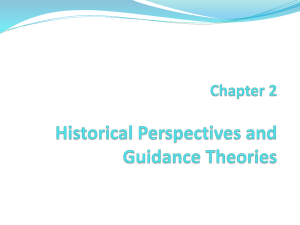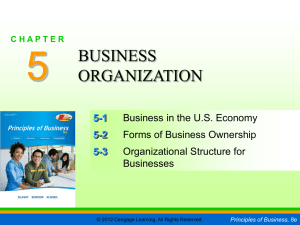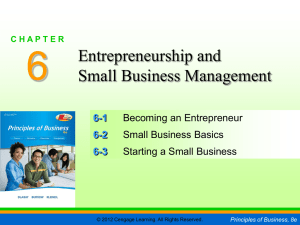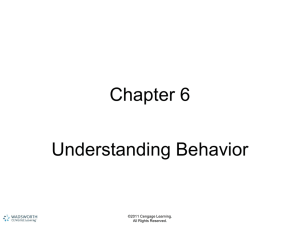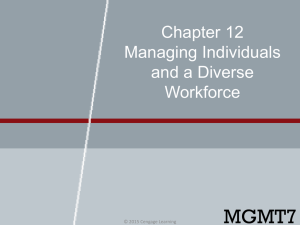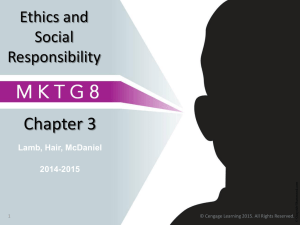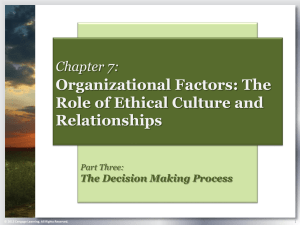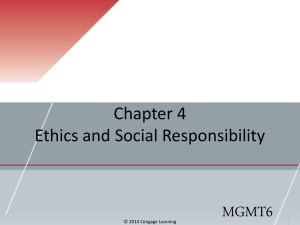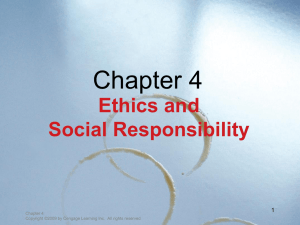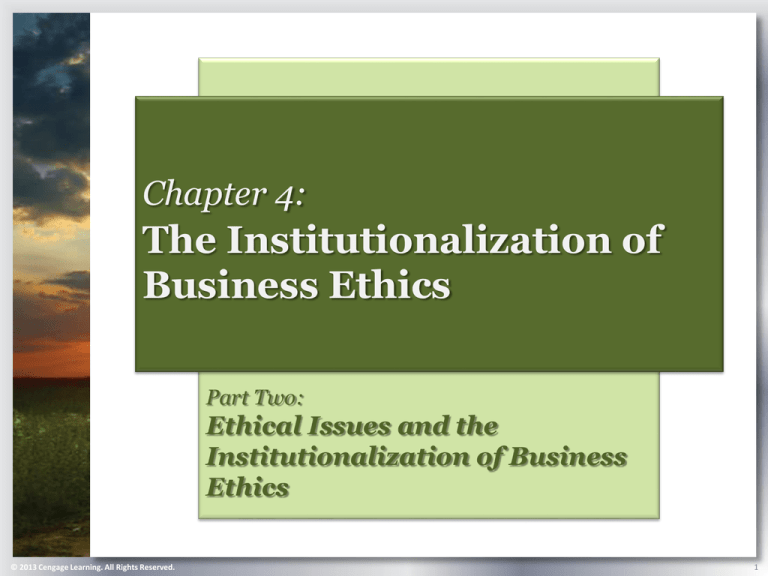
Chapter 4:
The Institutionalization of
Business Ethics
Part Two:
Ethical Issues and the
Institutionalization of Business
Ethics
© 2013 Cengage Learning. All Rights Reserved.
1
Institutionalization in Business
Ethics
Three dimensions to effective business
compliance
Voluntary practices: Include beliefs, values, and
voluntary contractual obligations of a business
All businesses have some voluntary commitments
Philanthropy: Giving back to communities and causes
Core practices: Documented best practices, often
encouraged by legal and regulatory forces and
trade associations
The Better Business Bureau can provide direction
Mandated boundaries: Externally imposed
boundaries of conduct (e.g. laws, rules, and
regulations)
© 2013 Cengage Learning. All Rights Reserved.
2
Legal Compliance
Laws and regulations established by
governments
Set minimum standards for responsible behavior
Laws regulating businesses are required because
stakeholders believe businesses cannot be trusted
to do what is right in some areas
Consumer safety
Environmental protection
Policy changes over time in response to business
abuses and consumer demands for safety
Telling employees to obey the law is meaningless
without training in legal risk areas
© 2013 Cengage Learning. All Rights Reserved.
3
The Elements of an Ethical Culture
© 2013 Cengage Learning. All Rights Reserved.
4
Types of Laws
Civil law defines the rights and duties of
individuals and organizations
Individuals (in court) enforce civil laws
Criminal law prohibits specific actions and
imposes punishments for breaking the law
State or nation enforces criminal laws
© 2013 Cengage Learning. All Rights Reserved
5
Relationship Between Top Management Talking about
Ethics and Employees NOT Observing Misconduct
© 2013 Cengage Learning. All Rights Reserved.
6
Mandated Requirement for Legal
Compliance
Laws establish the basic ground rules for
responsible business activities
Five categories of laws
1.
2.
3.
4.
5.
© 2013 Cengage Learning. All Rights Reserved.
Regulating competition
Protecting consumers
Protecting equity and safety
Protecting the environment
Incentives to encourage organizational compliance
programs
7
Laws Regulating Competition
Laws passed to prevent the establishment
of monopolies, inequitable pricing, and
other practices that reduce or restrict
competition among businesses
Sometimes called procompetitive legislation
because they encourage competition and
prevent activities that restrain trade
© 2013 Cengage Learning. All Rights Reserved.
8
Laws Protecting Consumers
Laws protecting consumers require businesses to
provide accurate information about products and
services and to follow safety standards
The first consumer protection law was passed in 1906
in response to poor working conditions in factories
The FTC’s Bureau of Consumer Protection protects
consumers against unfair, deceptive, or fraudulent
practices
The FDA regulates food safety, human drugs, and
tobacco, among other things
Groups with specific vulnerabilities have higher
levels of legal protection
© 2013 Cengage Learning. All Rights Reserved.
9
Laws Promoting Equity and Safety
Laws promoting equity in the workplace protect the
rights of minorities, women, older persons, and
disabled persons
Title VII of the Civil Rights Act
Equal Employment Opportunity Commission (EEOC)
Affirmative action programs
The Equal Pay Act
Occupational Safety and Health Administration
(OSHA) makes inspections to ensure a safe working
environment
•
•
© 2013 Cengage Learning. All Rights Reserved.
Many people still work in unsafe environments
Companies may underreport accidents to avoid inspection
and regulation
10
Laws Protecting the Environment
Created in response to stakeholder concerns
about businesses’ impact on environment
Sustainability
Meeting the present needs without compromising
future generations’ abilities to meet their own needs
Being a green company can boost profits
The Environmental Protection Agency (EPA) was
created to coordinate environmental agencies
Waste disposal is a serious problem for firms
and individuals
© 2013 Cengage Learning. All Rights Reserved.
11
The Green Consumer
Which age groups are willing to pay significantly more for green products?
© 2013 Cengage Learning. All Rights Reserved.
12
Gatekeepers and Stakeholders
Trust is the glue that holds businesses
together
Gatekeepers: Overseers of business actions
Accountants, regulators, lawyers, financial rating
firms, auditors
Are critical in providing accurate information to
stakeholders
© 2013 Cengage Learning. All Rights Reserved.
13
Accountants
Measure and disclose financial information
to the public
Assure accuracy
Some accountants have not adhered to their
stakeholder responsibilities
•
•
© 2013 Cengage Learning. All Rights Reserved.
Excessive focus on growth and profits
Conflicts of interest
14
Risk Assessors
A group that failed in its duties to
stakeholders during the most recent
recession
Problems with risk models led to inaccurate
ratings
Misled investors and stakeholders
More oversight of credit rating firms in the
future?
© 2013 Cengage Learning. All Rights Reserved.
15
The Sarbanes-Oxley (SOX) Act
Established a system of federal oversight of
corporate accounting practices
Gives the Public Company Accounting Oversight
Board (PCAOB) authority to monitor accounting
firms
Standards and rules for auditors in accounting firms
Requires top managers to certify their firms’
financial reports
More accountability for CEOs and CFOs
Some legal protection for whistleblowers
Loopholes existed and misconduct continued
© 2013 Cengage Learning. All Rights Reserved.
16
Dodd-Frank Wall Street Reform
and Consumer Protection Act
The most sweeping consumer protection
legislation since the Great Depression
Seeks to improve financial regulation, increase
oversight, and prevent excessive risk-taking and
deceptive practices
Created new offices
The Office of Financial Research
The Financial Stability Oversight Council
The Consumer Financial Protection Bureau (CFPB)
Increased whistle-blower protections
Whistle-blower bounty program
© 2013 Cengage Learning. All Rights Reserved.
17
Federal Sentencing Guidelines for
Organizations
Passed as an incentive for organizations to
develop and implement programs for
ethical and legal compliance
Applies to all felonies and class-A
misdemeanors committed by employees
Philosophy that legal violations can be
prevented through organizational values and
commitment to ethical conduct
Passed in 1991; amendments in 2004, 2008,
and 2010
© 2013 Cengage Learning. All Rights Reserved.
18
Employees Who Feel Better Prepared are
More Likely to Report
© 2013 Cengage Learning. All Rights Reserved.
19
Highly Appropriate Core Practices
Focus on developing sound organizational
practices and structural integrity for
performance measures
Not a focus on individual morals
Most ethical issues relate to nonfinancial
issues
The Sarbanes-Oxley Act and Dodd-Frank Act
provide standards for financial performance
The Integrity Institute developed a model that
standardizes measures for nonfinancial
performance
© 2013 Cengage Learning. All Rights Reserved.
20
Voluntary Responsibilities
Relate to business’ contributions to
stakeholders
Four major benefits
Improves quality of life in communities
Reduces government involvement
Develops employee leadership skills
Helps create an ethical culture
Cause-related marketing: Ties an organization’s
product(s) to a social concern through a marketing
program
Strategic philanthropy: The synergistic and
mutually beneficial use of a company’s core
competencies and resources to deal with social
issues
© 2013 Cengage Learning. All Rights Reserved.
21
The Importance of
Institutionalization in Business Ethics
Involves embedding values, norms, and
artifacts in organizations, industries, and
society
The failure to understand highly appropriate
core practices provides the opportunity for
unethical conduct
© 2013 Cengage Learning. All Rights Reserved.
22

